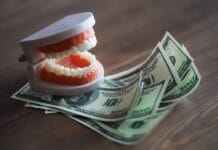The race of the clock, the fifth glare you’ve given your doctor in the last 10 minutes, the sweat dripping down your back, the panic rising, the need to strip off your lab coat and turn on your fan immediately, the pacing, the frantically trying to find and set up another op for your next patient. TIME MANAGEMENT – A topic we all know and share as a hygiene community.
Some of us are affected by this stressor more than others. Some hygienists are able to not stress and panic about the pressures of patient scheduling. Bless those souls and help me become more like them! But at some point, it affects us all. Unfortunately, this stress is something I battle with still, in my 12-year hygiene career.
I’ve talked with many hygienists about this topic. One seasoned dental hygienist nearing retirement whom I work with, was quite frazzled one day as she was leaving and I was just punching in. I asked her if this stress about time management ever gets better as one advances through their career. I mean, it has to, right? Her answer was no, with more and more duties added to our list of responsibilities, it has gotten worse for her. So how do we handle this, without running for the hills and a new career altogether (which truly may be the only solution for some)? What works for one hygienist may not work for another, but hopefully, you will find a nugget or two of wisdom that can help lighten your load and make clinical practice a little more enjoyable.
I’ve organized the tips below into two sections: practical tips and mental tips.
Practical Tips
Have open discussions with your doctors and front desk on the length of appointments.
With all that is on our plates and all the new things (intraoral camera pictures, Diagnodent, Iterro scanning, etc.), there is a lot to get done in a certain amount of time. I am blessed to have worked in practices where I usually get 90 minutes for new patients, 60 minutes for recalls, and 30-40 minutes for kids. However, there are the occasions where a new patient is squeezed into 60 minutes. We know how challenging that can be! It’s important that your front desk knows all the responsibilities and how long is needed to get it all done. Be open and honest and explain your needs, and hopefully, they will understand and accommodate. Try your best to be flexible when absolutely necessary.
Have an order to your appointments, and follow it precisely, each time.
This means find an order to all the tasks you have to do during an appointment: assessing patients’ chief complaints, reviewing health history/vitals, taking radiographs, head and neck exam, dental and periodontal charting, patient education, prophylaxis, polish, floss, doctor exam, charting, and room turnaround. You can easily Google “time management and dental hygiene” to find charts on how long each procedure should take you. I remember as a new grad it took a while to get into the groove of things and find my rhythm. Once you’ve been doing this a while, you will know in the back of your mind where you are and where you need to expedite.
Use of an automated or assisted perio charting systems.
Again, you can easily research automated perio charting systems, or ask a fellow staff member to assist you in charting. This can easily save you several minutes.
Call for the doctor’s exam when you are finished with your assessments and dental hygiene treatment plan.
This tip alone has been a huge lifesaver for me. Know what this eliminates? That pacing and glaring at the end of your appointment when you are waiting for the doctor to finish with his/her patient or the three other exams he/she needs to do before coming to you. It gives you a tiny piece of control in the mayhem of your day. Please have a discussion with your doctor and let them know this is something that will really help with the flow of your workday and will take some stress off of them too.
Come up with a system for an order of exams.
Which hygienist called for the doctor first? Sally, Mary, Justin? I don’t know how the doctors handle the stress of dealing with all of us! In the office I went to as a child, each hygienist had their own tile with their name painted on it. They would stack their tiles outside of whatever room the doctor was in, to let him/her know what order to go in. The doctor would return the tile to them when they came to do the exam. A little old-school, but it worked. Another office I worked at used the messaging system on their computer, and that worked great. Try to come up with a system, and it’ll save everyone time.
Pre-setup several (or all) trays for the day.
Just this simple step can be a huge stress reducer. You have the peace of knowing that once you have a clean room, you can just grab a pre-setup tray and you are good to go. It’s funny that even the step of ripping a piece of floss out of my little dispenser can be an extra 3 seconds I don’t have. So if I’ve already done that earlier in the day, it’s my little gift to myself, and one thing I can be in control of.
Set your clock ahead in your room.
Some hygienists like this method of time management. It ensures that you will almost always be on time, or ahead.
Have equipment that works.
Sensors issues, computer issues, ultrasonic/piezo tips that don’t work = huge frustration! Obviously, in an ideal world, everything would work right, 100% of the time. Work with your staff to ensure open communication about issues that may be going on, so those in charge can stay on top of repairs. See below (“Mental Tips”) to help manage when things do break down.
Help your teammates out.
What goes around comes around! If you have downtime, be kind and help your teammates with cleaning their rooms, or whatever else they may need. What goes around comes around, and sometime they’ll be able to return the favor.
Keep your instruments sharp.
Using dull instruments takes longer to remove calculus and stain, and will cause more strain on your body, and ultimately more mental stress. Find the time in your schedule to keep those babies sharp!
Polish first.
This is especially beneficial for my patients that have a moderate to high amount of plaque and/or stain. When I do this, it ensures that I don’t have to hand scale copious amounts of plaque/stain that comes off much more easily with polish and a cup. It’s also a little gift to yourself at the end when you’ve completed scaling because the polishing has already been done. Feels like one less thing you have to do.
USE your ultrasonic or Piezo. Just USE it!
This one is a little bit of a no-brainer, but for some reason, I can be a little lazy or hesitant to use it at times. Why? I think it’s the set-up of it, the water management, and patient management. Even the minute it takes to set it up will eliminate a lot of time in the cases of patients with a lot of buildup.
Use templates for writing patient notes.
Have a pre-scripted template that you can use to just alter the details to curtail it to each patient. This will save time and ensure you don’t miss important documentation details.
Stock your room either at the end of day or beginning of the day.
Having a fully stocked room will save you unbelievable amounts of irritating stress. You know that kind that sneaks up on you when everything is falling apart, and that’s the moment you realize your water bottle is empty, and all you feel like doing is crying!
Try to be honest with the patient about where you are time–
This goes both ways: when you may be running late, give them a heads-up that they’ll be in the waiting room for another 5-10 minutes. Or if your patient is late, let them know that you may not be able to get everything done today. Explain we have time to do X and Y today, but unfortunately, we don’t have time to do Z. This is a delicate subject, as we need to be comprehensive in our assessments and care. But perhaps a polish isn’t critical at this appointment. Or possibly they need to be rescheduled. Work with your front desk on scheduling and insurance matters to individualize it to patient’s needs.
Have a system for infection control.
This one has helped me a bunch too. As I am sitting the patient up, getting ready for dismissal, I throw all the disposables (suction tips, 2×2 gauze, dirty floss, varnish packaging/brush, patient napkin) away while I still have my gloves on. I then put my dirty instruments in the sink on top of a tray cover (and de-glove, sanitize hands). I dismiss my patient and can come right back in the room, re-glove, and start disinfecting the room. I then carry my instruments to sterilization and get them started in the sterilization process.
Mental Tips
“When you can’t control what’s happening, challenge yourself to control the way you respond to what’s happening. That is where your power is.”
I love this saying! I can’t quote it as my own; it came from the mysterious author of the Facebook memes. This one tip alone has helped me so much! Those moments when the X-ray sensor quits working, and you have a really difficult patient. Or when you are in the middle of sealants on a tricky patient, and you drop your suction. Ugh, we all know what that feels like! It is so easy for panic and frustration to set in when in those moments. Just say no! Take a deep breath (or five or ten), and move on. It’s not the end of the world, even though it feels like it at that second.
Change Your Focus
I’ve realized that I am guilty of just focusing on the clock when I am with a patient. It’s as if, once the patient walks in the door (and even before that, if they are running late), the clock starts going in my head, and that’s my main focus. I will be interviewing the patient, reviewing their health history, chief complaint, etc., and all I can think of is “tick-tock, tick-tock.” I’ve been working hard on trying to change my focus to that individual patient, and the HERE and NOW. NOT the 60 minutes I have with them, which are ticking away. Try picturing the patient as one of your loved ones, and providing the kind of care you would for one of them. I worked with a pediatric dentist who treated each patient with such care and individualized attention that patients and staff absolutely adored him. One of my goals is to try to be more like him in that way!
I am sure there are many more methods that are out there, and by no means is this a comprehensive list. Hopefully, this provides some encouragement and some tips to a struggling hygienist out there. Happy scaling!
Before you leave, check out the Today’s RDH self-study CE courses. All courses are peer-reviewed and non-sponsored to focus solely on high-quality education. Click here now.












